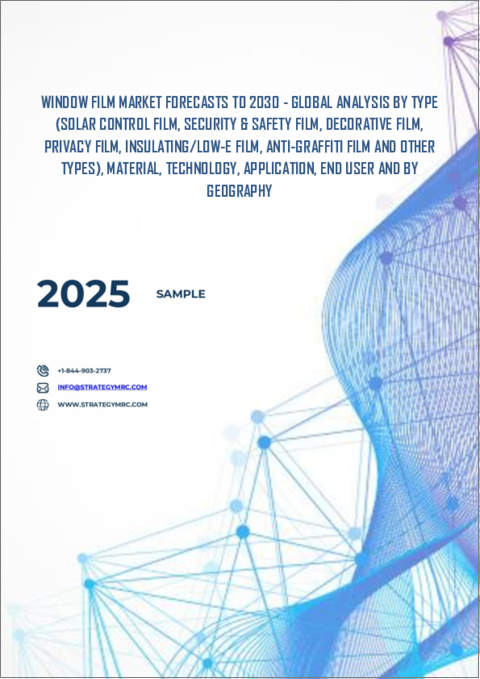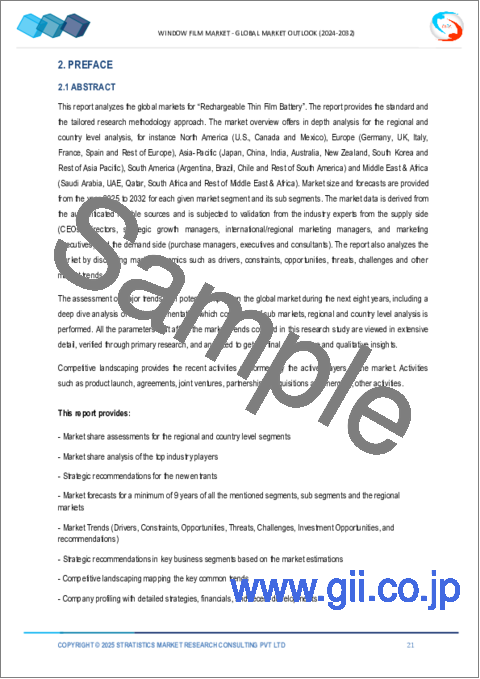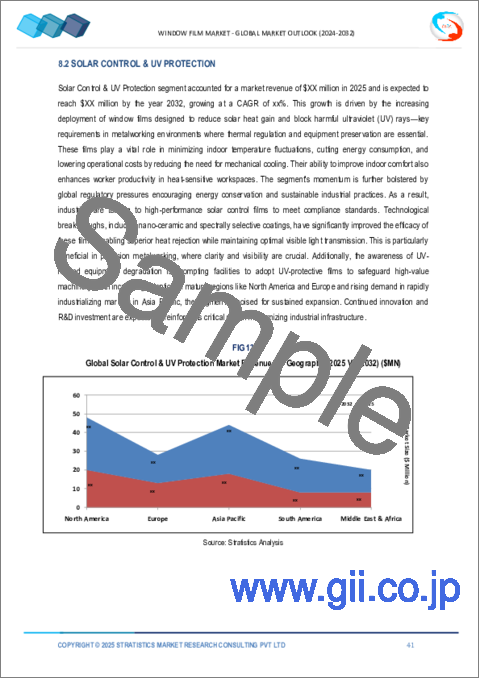|
|
市場調査レポート
商品コード
1679281
ウィンドウフィルム市場の2030年までの予測: タイプ別、素材別、技術別、用途別、エンドユーザー別、地域別の世界分析Window Film Market Forecasts to 2030 - Global Analysis By Type, Material, Technology, Application, End User and By Geography |
||||||
カスタマイズ可能
|
|||||||
| ウィンドウフィルム市場の2030年までの予測: タイプ別、素材別、技術別、用途別、エンドユーザー別、地域別の世界分析 |
|
出版日: 2025年03月03日
発行: Stratistics Market Research Consulting
ページ情報: 英文 200+ Pages
納期: 2~3営業日
|
全表示
- 概要
- 図表
- 目次
Stratistics MRCによると、ウィンドウフィルムの世界市場は2024年に22億米ドルを占め、予測期間中のCAGRは8.0%で成長し、2030年には35億米ドルに達する見込みです。
ウィンドウフィルムは、自動車、住宅、建物のガラス面に貼られる薄いラミネートコーティングです。通常、ポリエステルまたは同様のプラスチックから作られ、透明、着色、反射など様々なタイプがあります。これらのフィルムは、紫外線をカットし、室内を色あせから保護しながら、太陽熱の上昇を抑え、冷房コストを削減する、飛散したガラスをつなぎ合わせて怪我や侵入のリスクを減らすことでセキュリティを強化する、プライバシーのために自然光を遮ることなく空間への視界を制限する、模様や色、つや消し仕上げで美的魅力を加えるなど、さまざまな目的を果たします。また、模様や色、つや消し仕上げで美観を演出することもできます。ウィンドウフィルムは、このようなメリットを提供することで、さまざまな場面でエネルギー効率、安全性、プライバシー、美観に貢献します。
オートケア協会によると、米国を拠点とする独立系メーカー、部品店、修理工場、販売業者の数は50万を超えます。自動車用保護フィルムの需要は、事故の増加、直射日光による皮膚損傷の可能性などから増加しています。
エネルギー効率に対する意識の高まりとエネルギー消費削減の必要性
エネルギーコストが上昇を続ける中、住宅および商業施設の所有者は、エネルギー消費を最小限に抑え、光熱費を削減するソリューションを求めています。ウィンドウフィルムは、窓からの熱取得と熱損失を低減し、全体的なエネルギー効率を高める効果的な手段となります。さらに、持続可能性とグリーンビルディングの実践が重視されるようになり、エネルギー効率の高いウィンドウフィルムの採用が進んでいます。太陽制御や断熱特性など、ウィンドウフィルムにスマート技術が統合されたことで、市場での魅力がさらに高まっています。
耐久性とメンテナンスの問題
ウインドウフィルムには多くの利点があるが、紫外線暴露、温度変化、不適切な施工などの要因により、その寿命や性能が損なわれる可能性があります。時間が経つにつれて、ウィンドウフィルムは劣化したり、剥がれたり、変色したりして、効果が低下し、交換の必要性が出てきます。さらに、ウィンドウフィルムの外観や機能を維持するためには、定期的な清掃やメンテナンスが必要となり、不動産所有者にとっては面倒な作業となります。また、ウィンドウフィルムは長期的な投資ではなく短期的な解決策であるという認識も、市場の成長を妨げる可能性があります。
紫外線防止に関する懸念の高まり
紫外線(UV)に長時間さらされると、皮膚にダメージを与え、老化を早め、皮膚がんのリスクを高める可能性があります。UVカット特性を持つウィンドウフィルムは、有害な紫外線から居住者を守ることができるため、住宅、商業施設、自動車用途において魅力的な選択肢となっています。紫外線暴露に関連する健康リスクに対する意識の高まりが、優れたUV保護を提供するウィンドウフィルムへの需要を促進し、市場の成長を後押ししています。
自動車用着色に関する厳しい規制
様々な国や地域では、ドライバーの安全性と視認性を確保するために、自動車の窓に許容される着色レベルを規定する特定の規制があります。これらの規制に違反した場合、罰金や罰則が課せられ、違反したウィンドウフィルムの除去や交換が必要となります。異なる市場における色合い規制のばらつきは、メーカーや流通業者に課題をもたらし、一貫した製品を提供する能力に影響を与え、ウィンドウフィルム市場の成長をさらに制約することになります。
COVID-19の影響
ウィンドウフィルム市場はCOVID-19の発生により様々な影響を受けています。一方では、健康と安全が重視されるようになったため、抗菌性とセルフクリーニング性を備えたウィンドウフィルムの需要が急増しました。また、エネルギー効率と紫外線防止を目的とした住宅用ウィンドウフィルムも、パンデミックによる遠隔地での仕事や住宅リフォームの取り組みの急増の結果、人気が高まっています。しかし、市場はサプライチェーンの中断や経済の不確実性による困難に直面しており、これが製造や流通のオペレーションに影響を与えています。
予測期間中、プライバシーフィルム分野が最大となる見込み
プライバシーフィルムは、自然光を通しながら外部からの視認性を遮ることができるため、オフィス、浴室、店舗などの用途に最適であり、予測期間中、プライバシーフィルム分野が最大の市場シェアを占めると予想されます。人口密度の高い都市部におけるプライバシー保護ソリューションに対する需要の高まりや、オープンコンセプトのオフィススペースの動向が、プライバシー保護フィルムの採用を後押しし、市場の成長を促しています。
予測期間中、エレクトロクロミック&サーモクロミックセグメントのCAGRが最も高い見込み
予測期間中、エレクトロクロミック&サーモクロミックセグメントが最も高い成長率を示すと予測されます。これらの先進的なウィンドウフィルムは、快適性の向上、省エネ、まぶしさの軽減を実現し、幅広い用途に適しています。スマートビルディングやエネルギー効率の高いソリューションへの注目の高まりが、ウィンドウフィルム市場の普及を後押ししています。
最大のシェアを占める地域:
予測期間中、北米地域が最大の市場シェアを占めると予想されるが、これは大手市場プレイヤーの存在と研究開発への多額の投資がウィンドウフィルム市場における北米の地位をさらに強固なものにしているためです。また、グリーンビルディング基準の採用が増加し、商業ビルや住宅におけるエネルギー効率の高いソリューションに対する需要が高まっていることも、同地域の市場優位性を支えています。さらに、スマートホームやスマートオフィスの動向の高まりが、北米における高度なウィンドウフィルムの需要を牽引しています。
CAGRが最も高い地域:
予測期間中、アジア太平洋地域は最も高いCAGRを示すと予測されます。これは、エネルギー効率の高い建築慣行を促進する政府の取り組みと、インフラ開発への投資の増加が、この地域の高い成長率に貢献しているためです。中国、インド、日本のような国々は、大規模なプロジェクトや支援政策を実施しており、ウィンドウフィルム採用の最前線にいます。自動車産業の拡大、紫外線防止と省エネルギーに対する意識の高まりは、アジア太平洋地域における市場拡大の大きなチャンスをさらに生み出しています。
無料のカスタマイズサービス
本レポートをご購読のお客様には、以下の無料カスタマイズオプションのいずれかをご利用いただけます:
- 企業プロファイル
- 追加市場プレーヤーの包括的プロファイリング(3社まで)
- 主要企業のSWOT分析(3社まで)
- 地域セグメンテーション
- 顧客の関心に応じた主要国の市場推計・予測・CAGR(注:フィージビリティチェックによる)
- 競合ベンチマーキング
- 製品ポートフォリオ、地理的プレゼンス、戦略的提携に基づく主要企業のベンチマーキング
目次
第1章 エグゼクティブサマリー
第2章 序文
- 概要
- ステークホルダー
- 調査範囲
- 調査手法
- データマイニング
- データ分析
- データ検証
- 調査アプローチ
- 調査情報源
- 1次調査情報源
- 2次調査情報源
- 前提条件
第3章 市場動向分析
- 促進要因
- 抑制要因
- 機会
- 脅威
- 技術分析
- 用途分析
- エンドユーザー分析
- 新興市場
- COVID-19の影響
第4章 ポーターのファイブフォース分析
- 供給企業の交渉力
- 買い手の交渉力
- 代替品の脅威
- 新規参入業者の脅威
- 競争企業間の敵対関係
第5章 世界のウィンドウフィルム市場:タイプ別
- ソーラーコントロールフィルム
- セキュリティと安全フィルム
- 装飾フィルム
- プライバシーフィルム
- 断熱フィルム
- 落書き防止フィルム
- その他のタイプ
第6章 世界のウィンドウフィルム市場:素材別
- ビニール
- ポリエステル
- プラスチック
- セラミック
- その他の資料
第7章 世界のウィンドウフィルム市場:技術別
- 染色
- メタライジング
- Low-E(低放射率)コーティング
- エレクトロクロミック&サーモクロミック
- ラミネーション
- その他のテクノロジー
第8章 世界のウィンドウフィルム市場:用途別
- 日射制御と紫外線保護
- プライバシー
- 安全とセキュリティ
- 美学
- その他の用途
第9章 世界のウィンドウフィルム市場:エンドユーザー別
- 自動車
- 建築・建設
- 海洋・航空宇宙
- その他のエンドユーザー
第10章 世界のウィンドウフィルム市場:地域別
- 北米
- 米国
- カナダ
- メキシコ
- 欧州
- ドイツ
- 英国
- イタリア
- フランス
- スペイン
- その他欧州
- アジア太平洋
- 日本
- 中国
- インド
- オーストラリア
- ニュージーランド
- 韓国
- その他アジア太平洋地域
- 南米
- アルゼンチン
- ブラジル
- チリ
- その他南米
- 中東・アフリカ
- サウジアラビア
- アラブ首長国連邦
- カタール
- 南アフリカ
- その他中東とアフリカ
第11章 主な発展
- 契約、パートナーシップ、コラボレーション、合弁事業
- 買収と合併
- 新製品発売
- 事業拡大
- その他の主要戦略
第12章 企業プロファイリング
- 3M
- American Standard Window Film
- Armolan Window Films
- Avery Dennison Corporation
- Eastman Chemical Company
- Garware Suncontrol
- Hanita Coatings RCA Ltd
- Hyosung Chemical
- Johnson Window Films, Inc
- Lintec Corporation
- Madico, Inc
- Nexfil
- Rayno Window Film
- Reflectiv Window Films
- Saint-Gobain Performance Plastics Corporation
- Toray Plastics Inc
List of Tables
- Table 1 Global Window Film Market Outlook, By Region (2022-2030) ($MN)
- Table 2 Global Window Film Market Outlook, By Type (2022-2030) ($MN)
- Table 3 Global Window Film Market Outlook, By Solar Control Film (2022-2030) ($MN)
- Table 4 Global Window Film Market Outlook, By Security & Safety Film (2022-2030) ($MN)
- Table 5 Global Window Film Market Outlook, By Decorative Film (2022-2030) ($MN)
- Table 6 Global Window Film Market Outlook, By Privacy Film (2022-2030) ($MN)
- Table 7 Global Window Film Market Outlook, By Insulating/Low-E Film (2022-2030) ($MN)
- Table 8 Global Window Film Market Outlook, By Anti-Graffiti Film (2022-2030) ($MN)
- Table 9 Global Window Film Market Outlook, By Other Types (2022-2030) ($MN)
- Table 10 Global Window Film Market Outlook, By Material (2022-2030) ($MN)
- Table 11 Global Window Film Market Outlook, By Vinyl (2022-2030) ($MN)
- Table 12 Global Window Film Market Outlook, By Polyester (2022-2030) ($MN)
- Table 13 Global Window Film Market Outlook, By Plastic (2022-2030) ($MN)
- Table 14 Global Window Film Market Outlook, By Ceramic (2022-2030) ($MN)
- Table 15 Global Window Film Market Outlook, By Other Materials (2022-2030) ($MN)
- Table 16 Global Window Film Market Outlook, By Technology (2022-2030) ($MN)
- Table 17 Global Window Film Market Outlook, By Dyeing (2022-2030) ($MN)
- Table 18 Global Window Film Market Outlook, By Metallizing (2022-2030) ($MN)
- Table 19 Global Window Film Market Outlook, By Low-E (Low Emissivity) Coating (2022-2030) ($MN)
- Table 20 Global Window Film Market Outlook, By Electrochromic & Thermochromic (2022-2030) ($MN)
- Table 21 Global Window Film Market Outlook, By Lamination (2022-2030) ($MN)
- Table 22 Global Window Film Market Outlook, By Other Technologies (2022-2030) ($MN)
- Table 23 Global Window Film Market Outlook, By Application (2022-2030) ($MN)
- Table 24 Global Window Film Market Outlook, By Solar Control & UV Protection (2022-2030) ($MN)
- Table 25 Global Window Film Market Outlook, By Privacy (2022-2030) ($MN)
- Table 26 Global Window Film Market Outlook, By Safety & Security (2022-2030) ($MN)
- Table 27 Global Window Film Market Outlook, By Aesthetics (2022-2030) ($MN)
- Table 28 Global Window Film Market Outlook, By Other Applications (2022-2030) ($MN)
- Table 29 Global Window Film Market Outlook, By End User (2022-2030) ($MN)
- Table 30 Global Window Film Market Outlook, By Automotive (2022-2030) ($MN)
- Table 31 Global Window Film Market Outlook, By Building & Construction (2022-2030) ($MN)
- Table 32 Global Window Film Market Outlook, By Marine & Aerospace (2022-2030) ($MN)
- Table 33 Global Window Film Market Outlook, By Other End Users (2022-2030) ($MN)
Note: Tables for North America, Europe, APAC, South America, and Middle East & Africa Regions are also represented in the same manner as above.
According to Stratistics MRC, the Global Window Film Market is accounted for $2.2 billion in 2024 and is expected to reach $3.5 billion by 2030 growing at a CAGR of 8.0% during the forecast period. Window film is a thin laminate coating applied to glass surfaces in vehicles, homes, and buildings. Typically made from polyester or similar plastics, it comes in various types including transparent, tinted, and reflective. These films serve multiple purposes: reducing solar heat gain and cooling costs while blocking UV rays and protecting interiors from fading; enhancing security by holding shattered glass together to reduce the risk of injury or intrusion; limiting visibility into spaces without obstructing natural light for privacy; and adding aesthetic appeal with patterns, colors, or frosted finishes. By offering these benefits, window films contribute to energy efficiency, safety, privacy, and aesthetics in various settings.
According to the Auto Care Association, there have been more than 500,000 independent U.S.-based manufacturers, part stores, repair shops, and distributors. The demand for automotive protective films is increasing due to a rise in accidents, potential skin damage from direct sunlight.
Market Dynamics:
Driver:
Increasing awareness of energy efficiency and the need to reduce energy consumption
As energy costs continue to rise, both residential and commercial property owners are seeking solutions to minimize energy use and lower utility bills. Window films provide an effective means of reducing heat gain and heat loss through windows, thereby enhancing overall energy efficiency. Additionally, the growing emphasis on sustainability and green building practices is driving the adoption of energy-efficient window films. The integration of smart technology into window films, such as solar control and thermal insulation properties, further enhances their appeal in the market.
Restraint:
Durability and maintenance issues
Window films offer numerous benefits; their longevity and performance can be compromised by factors such as UV exposure, temperature fluctuations, and improper installation. Over time, window films may deteriorate, peel, or discolor, leading to reduced effectiveness and the need for replacement. Additionally, maintaining the appearance and functionality of window films requires regular cleaning and upkeep, which can be cumbersome for property owners. The perception of window films as a short-term solution rather than a long-lasting investment can also hinder market growth.
Opportunity:
Rising concerns about UV protection
Prolonged exposure to ultraviolet (UV) rays can cause skin damage, premature aging, and increase the risk of skin cancer. Window films with UV-blocking properties can protect occupants from harmful UV radiation, making them an attractive option for residential, commercial, and automotive applications. The growing awareness of the health risks associated with UV exposure is driving demand for window films that offer superior UV protection propelling the market growth.
Threat:
Stringent regulations on automotive tinting
Various countries and regions have specific regulations governing the allowable tint levels on vehicle windows to ensure safety and visibility for drivers. Non-compliance with these regulations can result in fines, penalties, and the need to remove or replace non-compliant window films. The variability of tinting regulations across different markets can create challenges for manufacturers and distributors, impacting their ability to provide consistent products further constrain the growth of the window film market.
Covid-19 Impact
The market for window film has been affected by the COVID-19 outbreak in a variety of ways. On the one hand, demand for window films with antimicrobial and self-cleaning qualities has surged due to the growing emphasis on health and safety. Residential window films for energy efficiency and UV protection have also become more popular as a result of the pandemic's surge in remote work and home renovation initiatives. However, the market has faced difficulties due to supply chain interruptions and economic uncertainty, which have affected manufacturing and distribution operations.
The privacy film segment is expected to be the largest during the forecast period
The privacy film segment is expected to account for the largest market share during the forecast period because these films can obscure visibility from the outside while allowing natural light to pass through, making them ideal for applications in offices, bathrooms, and storefronts. The increasing demand for privacy solutions in densely populated urban areas and the growing trend of open-concept office spaces are driving the adoption of privacy films encouraging the growth of the market.
The electrochromic & thermochromic segment is expected to have the highest CAGR during the forecast period
Over the forecast period, the electrochromic & thermochromic segment is predicted to witness the highest growth rate as they offer dynamic and responsive light control by changing their tint level based on external stimuli such as temperature and voltage. These advanced window films provide enhanced comfort, energy savings, and glare reduction, making them suitable for a wide range of applications. The growing focus on smart buildings and energy-efficient solutions is driving the adoption of window film market.
Region with largest share:
During the forecast period, the North America region is expected to hold the largest market share attributed to the presence of major market players and significant investments in research and development further strengthen North America's position in the Window Film market. The increasing adoption of green building standards and the rising demand for energy-efficient solutions in commercial and residential buildings also support the region's market dominance. Additionally, the growing trend of smart homes and smart offices drives the demand for advanced window films in North America.
Region with highest CAGR:
Over the forecast period, the Asia Pacific region is anticipated to exhibit the highest CAGR owing to government initiatives promoting energy-efficient building practices and the rising investments in infrastructure development contribute to the high growth rate in this region. Countries like China, India, and Japan are at the forefront of window film adoption, with large-scale projects and supportive policies in place. The expanding automotive industry and the growing awareness of UV protection and energy savings further create substantial opportunities for market expansion in the Asia Pacific region.
Key players in the market
Some of the key players in Window Film market include 3M, American Standard Window Film, Armolan Window Films, Avery Dennison Corporation, Eastman Chemical Company, Garware Suncontrol, Hanita Coatings RCA Ltd, Hyosung Chemical, Johnson Window Films, Inc, Lintec Corporation, Madico, Inc, Nexfil, Rayno Window Film, Reflectiv Window Films, Saint-Gobain Performance Plastics Corporation and Toray Plastics Inc.
Key Developments:
In February 2025, Saint-Gobain has completed the acquisition announced of FOSROC, a leading global construction chemicals player with a strong geographic footprint in India, the Middle East and Asia-Pacific in particular.
In January 2025, Eastman introduced the latest innovation in its sustainable fiber portfolio today at Heimtextil trade fair in Frankfurt, Germany. Eastman Naia(TM) Renew cellulosic fiber for fill applications expands beyond the brand's success in bedding and towels.
In December 2024, 3M and US Conec Ltd. announced a strategic licensing agreement for 3M(TM) Expanded Beam Optical Interconnect technology; a solution to meet the performance and scalability needs of next-generation data centers and advanced network architectures.
Types Covered:
- Solar Control Film
- Security & Safety Film
- Decorative Film
- Privacy Film
- Insulating/Low-E Film
- Anti-Graffiti Film
- Other Types
Materials Covered:
- Vinyl
- Polyester
- Plastic
- Ceramic
- Other Materials
Technologies Covered:
- Dyeing
- Metallizing
- Low-E (Low Emissivity) Coating
- Electrochromic & Thermochromic
- Lamination
- Other Technologies
Applications Covered:
- Solar Control & UV Protection
- Privacy
- Safety & Security
- Aesthetics
- Other Applications
End Users Covered:
- Automotive
- Building & Construction
- Marine & Aerospace
- Other End Users
Regions Covered:
- North America
- US
- Canada
- Mexico
- Europe
- Germany
- UK
- Italy
- France
- Spain
- Rest of Europe
- Asia Pacific
- Japan
- China
- India
- Australia
- New Zealand
- South Korea
- Rest of Asia Pacific
- South America
- Argentina
- Brazil
- Chile
- Rest of South America
- Middle East & Africa
- Saudi Arabia
- UAE
- Qatar
- South Africa
- Rest of Middle East & Africa
What our report offers:
- Market share assessments for the regional and country-level segments
- Strategic recommendations for the new entrants
- Covers Market data for the years 2022, 2023, 2024, 2026, and 2030
- Market Trends (Drivers, Constraints, Opportunities, Threats, Challenges, Investment Opportunities, and recommendations)
- Strategic recommendations in key business segments based on the market estimations
- Competitive landscaping mapping the key common trends
- Company profiling with detailed strategies, financials, and recent developments
- Supply chain trends mapping the latest technological advancements
Free Customization Offerings:
All the customers of this report will be entitled to receive one of the following free customization options:
- Company Profiling
- Comprehensive profiling of additional market players (up to 3)
- SWOT Analysis of key players (up to 3)
- Regional Segmentation
- Market estimations, Forecasts and CAGR of any prominent country as per the client's interest (Note: Depends on feasibility check)
- Competitive Benchmarking
- Benchmarking of key players based on product portfolio, geographical presence, and strategic alliances
Table of Contents
1 Executive Summary
2 Preface
- 2.1 Abstract
- 2.2 Stake Holders
- 2.3 Research Scope
- 2.4 Research Methodology
- 2.4.1 Data Mining
- 2.4.2 Data Analysis
- 2.4.3 Data Validation
- 2.4.4 Research Approach
- 2.5 Research Sources
- 2.5.1 Primary Research Sources
- 2.5.2 Secondary Research Sources
- 2.5.3 Assumptions
3 Market Trend Analysis
- 3.1 Introduction
- 3.2 Drivers
- 3.3 Restraints
- 3.4 Opportunities
- 3.5 Threats
- 3.6 Technology Analysis
- 3.7 Application Analysis
- 3.8 End User Analysis
- 3.9 Emerging Markets
- 3.10 Impact of Covid-19
4 Porters Five Force Analysis
- 4.1 Bargaining power of suppliers
- 4.2 Bargaining power of buyers
- 4.3 Threat of substitutes
- 4.4 Threat of new entrants
- 4.5 Competitive rivalry
5 Global Window Film Market, By Type
- 5.1 Introduction
- 5.2 Solar Control Film
- 5.3 Security & Safety Film
- 5.4 Decorative Film
- 5.5 Privacy Film
- 5.6 Insulating/Low-E Film
- 5.7 Anti-Graffiti Film
- 5.8 Other Types
6 Global Window Film Market, By Material
- 6.1 Introduction
- 6.2 Vinyl
- 6.3 Polyester
- 6.4 Plastic
- 6.5 Ceramic
- 6.6 Other Materials
7 Global Window Film Market, By Technology
- 7.1 Introduction
- 7.2 Dyeing
- 7.3 Metallizing
- 7.4 Low-E (Low Emissivity) Coating
- 7.5 Electrochromic & Thermochromic
- 7.6 Lamination
- 7.7 Other Technologies
8 Global Window Film Market, By Application
- 8.1 Introduction
- 8.2 Solar Control & UV Protection
- 8.3 Privacy
- 8.4 Safety & Security
- 8.5 Aesthetics
- 8.6 Other Applications
9 Global Window Film Market, By End User
- 9.1 Introduction
- 9.2 Automotive
- 9.3 Building & Construction
- 9.4 Marine & Aerospace
- 9.5 Other End Users
10 Global Window Film Market, By Geography
- 10.1 Introduction
- 10.2 North America
- 10.2.1 US
- 10.2.2 Canada
- 10.2.3 Mexico
- 10.3 Europe
- 10.3.1 Germany
- 10.3.2 UK
- 10.3.3 Italy
- 10.3.4 France
- 10.3.5 Spain
- 10.3.6 Rest of Europe
- 10.4 Asia Pacific
- 10.4.1 Japan
- 10.4.2 China
- 10.4.3 India
- 10.4.4 Australia
- 10.4.5 New Zealand
- 10.4.6 South Korea
- 10.4.7 Rest of Asia Pacific
- 10.5 South America
- 10.5.1 Argentina
- 10.5.2 Brazil
- 10.5.3 Chile
- 10.5.4 Rest of South America
- 10.6 Middle East & Africa
- 10.6.1 Saudi Arabia
- 10.6.2 UAE
- 10.6.3 Qatar
- 10.6.4 South Africa
- 10.6.5 Rest of Middle East & Africa
11 Key Developments
- 11.1 Agreements, Partnerships, Collaborations and Joint Ventures
- 11.2 Acquisitions & Mergers
- 11.3 New Product Launch
- 11.4 Expansions
- 11.5 Other Key Strategies
12 Company Profiling
- 12.1 3M
- 12.2 American Standard Window Film
- 12.3 Armolan Window Films
- 12.4 Avery Dennison Corporation
- 12.5 Eastman Chemical Company
- 12.6 Garware Suncontrol
- 12.7 Hanita Coatings RCA Ltd
- 12.8 Hyosung Chemical
- 12.9 Johnson Window Films, Inc
- 12.10 Lintec Corporation
- 12.11 Madico, Inc
- 12.12 Nexfil
- 12.13 Rayno Window Film
- 12.14 Reflectiv Window Films
- 12.15 Saint-Gobain Performance Plastics Corporation
- 12.16 Toray Plastics Inc






